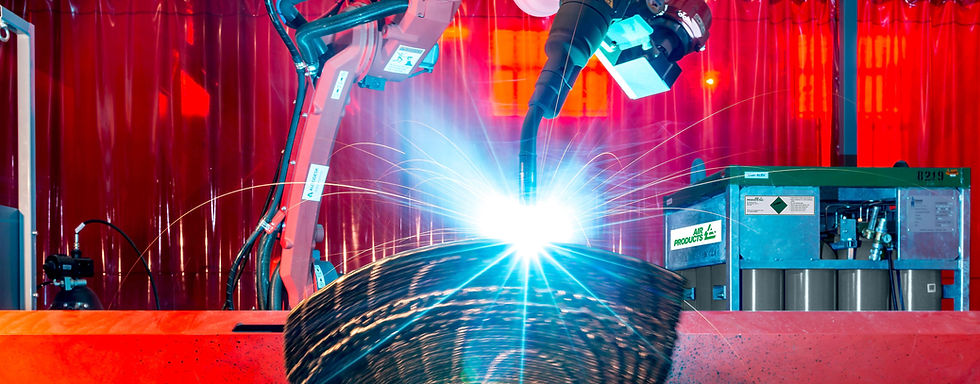New WAAM application - cooling channels to increase forging tool life and to improve forging process
- aenserink
- Sep 14, 2022
- 3 min read
Tools in hot forging processes are subjected to extreme heat loads. In some processes, their temperature exceeds the 600°C barrier - the maximum operating temperature for hot work tool steels. This results in tempering and accelerated degradation of the surface layer of these tools.

Cooling is used to prevent overheating. Conventionally, cooling is achieved by spraying or flooding the forging die surface with liquid. The surface heated by contact with the forging is then rapidly cooled. In many cases, when the contact between the die and the forging is long or the forging cycle is very frequent, cooling from the surface is not sufficient. Overheating of the layers immediately below the surface occurs and their temperature periodically rises above 600°C.
An alternative concept to reduce the tool temperature is cooling from the inside. This consists of running cooling channels through which the liquid flows. These channels are traditionally made by drilling or hollowing straight intersecting sections. This method is limited because the channels cannot be made along a curved line and therefore cannot be run close to the surface at a precise distance from the heat source. For this reason and due to the high manufacturing costs, channels are not popular in forging tools.
Additive technologies such as WAAM may be the answer to forging needs. They allow the manufacture of conformal cooling channels of if their design includes the constraints of the WAAM process. These channels can be located close to the areas most affected by heat and thus enable uniform heat dissipation preventing overheating. This is an extremely valuable capability, especially as it has not been available or known in forging until now. The new cooling capabilities will reduce overheating and therefore tool wear. They increase durability and wear resistance, as the hardness and strength of steel is temperature dependent.
The second revolutionary effect of additive cooling channel technology is the ability to increase the efficiency of the forging process. Speeding up the process and shortening the forging cycle involves reducing tool cooling time. Thanks to the possibility of cooling from the inside, which is provided by the channels created additively with the WAAM technology, the tool cycle can be shortened and productivity increased. This is particularly useful in automated forging processes, where real acceleration of robots or manipulators is possible.
The benefit of using WAAM additive technology for tool cooling brings increased tool life and improved process efficiency. Both of these factors are key in terms of minimising unit production costs for forgings.
Technological progress is possible, although it requires overcoming several challenges. Firstly, the channels must be built at a safe distance from the surface so as not to reduce load strength. Secondly, the channels should be as round as possible for strength reasons and to prevent cracking. The shape of the cross-section is important in view of the flowing liquid, the flow of which can be turbulent or even stopped at certain points due to obstructions. In addition, the channel should be designed so that it cools optimally, not too weakly and not too strongly. Ultimately, the design of the cooling channels in forging tools must be tailored to the operating conditions of the individual tool while considering the manufacturing constraints. This requires analysis, measurement of the temperature during operation, which also sometimes has to be supported by numerical modelling.
WAAM technology as one of the most efficient additive methods is recommended for the production and regeneration of forging tools. It can be successfully used to apply anti-wear layers and to create conformal cooling channels in the die. It is particularly dedicated to larger dies weighing more than 50 kg due to the high-energy processing and significant material deposition rate (e.g. 5 kg/h) in contrast to low-energy methods with low, often insufficient productivity.
Author : Paweł Widomski, PhD, Wroclaw University of Science and Technology




Comments